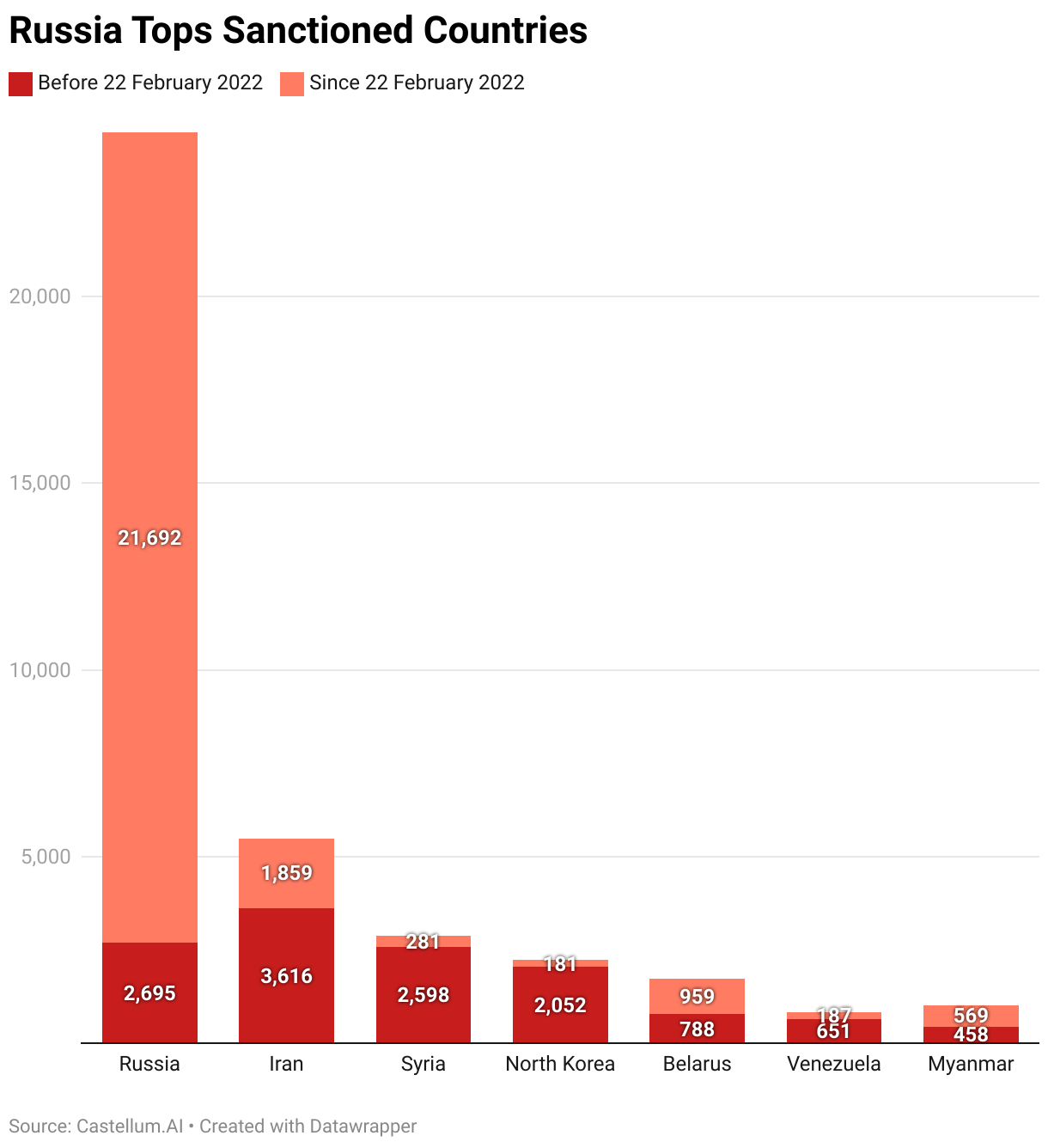How sanctions shape global economies: the domino effect of economic penalties

When countries get into diplomatic spats these days, they're more likely to reach for their wallets than their weapons. Welcome to the world of economic sanctions, where the power of the purse has become the preferred tool of international pressure. Grab a coffee, and let's unpack this diplomatic-but-not-really-diplomatic tool.
The sanctions toolkit: more than just saying "No trade for you!"
First thing first. Sanctions are not always negative, in fact there are also positive sanctions. The difference is simple:
- Negative sanctions: people normally refer to this model, they are punitive measures put in place by a sender state or group of states to cause or threaten economic damage to a target state.
- Positive sanctions: these are the assignment (or promise of assignment) of economic benefits by sender states with the aim of shaping a target state's behaviour and strategy . These can include trade policy measures that favour trade, development aid, technological cooperation, cross-border infrastructure, or repayment
For the sake of this article let's focus on the negative type.
Imagine you have a neighbor playing ridiculously loud polka music at 3 AM every night. You've tried talking, pleading, even leaving passive-aggressive notes. Your next step, short of calling the cops (or, in global politics, starting a war), might be to stop lending them your lawnmower or refuse to accept their packages. That's the basic idea behind sanctions: using economic leverage to make someone rethink their actions.
They sit in that awkward middle ground between a sternly worded letter and military action. Countries use them to:
- Coerce: "Stop doing that thing we don't like."
- Deter: "Don't even think about doing that thing."
- Punish: "You did the thing, now face the consequences."
- Shame: "Everyone sees you doing the thing, and it's not cool.
And boy, have they become popular. Since the Cold War ended, it's like someone opened the sanctions floodgates. The U.S., for instance, went from using them occasionally to making them almost a default setting - usage reportedly shot up over 900% between 2000 and 2021! The UN isn't far behind, setting up dozens of sanctions regimes.

Sanctions come in flavors:
- Trade sanctions: think restricting imports/exports to multiple degrees. The main types are:
- Embargo: prohibition of exports. It implies that no goods and services will be supplied to the buyer.
- Boycotts: blocks on imports. It involves the refusal to purchase goods and services from a supplier.
- Tariff increases: an increase in taxes on imports from target state(s).
- Blacklist: a ban on doing business with firms that trade with the target country.
- Quotas: quantitative restrictions on particular imports or exports.
- License denial: refusing permission to import or export particular goods.
- A combination of the above.
- Financial sanctions: freezing assets (like the billions in Russian central bank funds frozen in 2022), blocking loans, restrict investments into a state, or kicking countries out of the financial playground (like the SWIFT banking network).
- Targeted ("smart") sanctions: going after specific people or companies with asset freezes or travel bans to minimize hurting innocent bystanders.
- Sectoral sanctions: taking aim at key industries, like energy or banking.
- Secondary sanctions: the "you're friends with them, so now I'm mad at you too" approach. Penalizing other countries or companies for dealing with the main target. Think Star Wars' Empire going after anyone helping the Rebels.
- More flavors: mandatory vs voluntary (as in, states have to apply them or have a say), unilateral vs multilateral (imposed by one vs multiple states against another), travel, military assistance, etc.
Sounds neat, right? A way to flex political muscle without the cost of war? Well, hold your horses... it's way more complicated, and whether they actually work is a massive debate. Let's look at some real-world drama.
Case study #1: Cuba - the never-ending embargo
Picture those iconic, colorful vintage American cars cruising Havana's streets. They're cool, sure, but they're also a rolling symbol of the longest trade embargo in modern history - over 60 years!

- The why: it started back in the early 60s after the Cuban Revolution when Fidel Castro's government started expropriating American-owned oil refineries. Soon after Castro nationalized hundreds of millions of dollars of US properties. Ultimately though it was used as tool of Cold War statecraft aimed at punishing Cuba's alignment with the Soviet Union. Declassified docs basically said the goal was to make life so miserable ("hunger, desperation") that Cubans would overthrow the government. Spoiler: that didn't happen.
- The squeeze: a near-total ban on trade and financial dealings. Imagine suddenly losing access to your biggest customer and supplier (which the U.S. was for Cuba).
- The fallout (Cuba): huge economic pain - estimates run into the hundreds of billions, maybe even trillions over the decades. It choked off access to markets, cash, and vital goods, making Cuba's own economic problems worse. Think shortages of everything, including food and medicine. Even though medicine is technically exempt, the rules are so complex and banks are so scared of breaking them, that getting supplies in is a nightmare.
- The fallout (U.S. & World): the U.S. also lost billions in potential trade. Plus, pretty much the entire world tells the U.S. every year at the UN that the embargo is a bad idea. Talk about being isolated.
- Why no regime change? Cuba managed to rely on other partners (not just the Soviet Union, but China, UK, Canada and EU among others), adapting and frankly, the embargo became a handy excuse for the Cuban government to blame its problems on Uncle Sam. It might have even boosted nationalism.
Fun fact: The United States' economic embargo against Cuba ("el bloqueo"), which began with arms restrictions in 1958 and expanded significantly in 1962, is one of the longest-standing sanction regimes in modern history.
The takeaway: slapping a massive, long-term, unilateral embargo on someone, even if you're a superpower, doesn't guarantee you'll get the political outcome you want (like regime change). It definitely causes pain, but targets adapt, and it can even backfire on the sender.
Case study #2: Iran - nukes, deals, and maximum squeeze
Iran's been in the sanctions spotlight for decades, mostly thanks to concerns about its nuclear program.
- The buildup: initial sanctions after the 1979 hostage crisis, a period when Iranian militants seized the U.S. Embassy in Tehran and held 52 American hostages for 444 days, then more in the 90s. But things really heated up in the 2000s when Iran's secret nuclear work came to light.
- Turning the screws: when talks stalled, the United Nations jumped in (starting 2006), followed by the U.S. and EU going hard around 2010-2012. They targeted Iran's lifeline - oil exports - and cut its banks off from the global financial system (SWIFT). They even used those secondary sanctions, threatening others who dealt with Iran.
- The economic maelstrom: This hurt. Badly.
- Oil sales? Plummeted.
- The economy? Shrank significantly.
- Inflation? Through the roof (averaging 27-36% during peak sanction periods!).
- The currency (rial)? Took a nosedive, crushing people's savings and buying power. Imagine your money losing nearly half its value against the dollar every year for a few years. Ouch.

- The deal & the reversal: The pain was a big reason Iran signed the 2015 nuclear deal (JCPOA), trading limits on its program for sanctions relief. Things started looking up economically. But then, the U.S. pulled out in 2018 under President Trump, slapped sanctions back on ("maximum pressure"), and the economy tanked again.
- The human cost: Like Cuba, even with "humanitarian exemptions," getting medicine became incredibly difficult. Banks got spooked ("over-compliance"), leading to shortages of critical drugs. Sanctions also tend to fuel corruption and black markets.
- Playing whack-a-mole: Iran got good at dodging sanctions – using front companies, shadowy shipping networks (the "dark fleet" turning off transponders), and finding alternative ways to trade. But the average person still bore the brunt.
The takeaway: Coordinated, tough sanctions, especially financial ones, can inflict massive economic damage and push a country to negotiate. But they come with severe humanitarian costs, political risks (like empowering hardliners), and targets will always try to find workarounds.
Case study #3: South Africa - The "It kind of worked?" Example
This is often held up as the poster child for sanctions achieving a major goal: dismantling apartheid. Apartheid was a system of racial segregation and discrimination enforced by the white minority government in South Africa from 1948 to 1994.
- The goal: clear and widely shared - end the racist system of apartheid and bring democracy to South Africa.
- The team effort: this wasn't just one country acting alone. It was a global campaign:
- Grassroots power: anti-apartheid movements worldwide protested, boycotted, and pressured governments. Think "Look at the Label" campaigns and student protests.
- Hitting the wallet: universities, churches, and cities pulled investments out of companies operating in South Africa (divestment).
- Official bans: governments passed laws. The big one was the U.S. Comprehensive Anti-Apartheid Act (CAAA) in 1986 - passed over President Reagan's veto! - banning new investments, loans, and key imports. Others followed suit.
- Cultural freeze-out: South Africa got kicked out of the Olympics and other sports. Artists and academics were urged not to visit.
- The impact: this multi-pronged pressure made apartheid increasingly costly and isolated the regime. The economy slowed, investment dried up, the currency weakened, and capital fled the country, leading to a debt crisis.
- Did sanctions alone do It? Probably not. Internal resistance (mass protests, strikes) and the changing global scene (end of the Cold War) were huge factors. But many, including Nelson Mandela, believed the international pressure, especially the financial squeeze and the powerful signal sent by laws like the CAAA, was crucial in convincing the white minority government that change was unavoidable. The psychological impact of being a global pariah shouldn't be underestimated either.

The takeaway: sanctions can contribute to major political change, especially when they are part of a broad, multilateral effort that combines economic pressure with political isolation and grassroots action. Teamwork makes the dream work, sometimes.
Case study #4: Russia and the "Special Military Operation"
After Russia decided to fully invade Ukraine in February 2022 (although officially called "Special Military Operation" by Russia), over 30 nations (including G7, EU and US) unleashed the most comprehensive sanctions ever seen against a major economy. Their mission: starve Russia's war chest, inflict pain on the state and elites, and hobble their future economic and tech game. The challenge? Getting all EU members to agree takes time. Plus, major players like China, India, and Turkey sat this one out, offering Russia escape routes.
The sanctions rolled out in phases, like adding levels to a video game difficulty:
- Level 1 (early 2022): shock & awe. Freezing the Central Bank's rainy-day fund, kicking key banks off SWIFT (the global banking chat line), and slapping broad export bans on tech.
- Level 2 (mid-2022 - 2023): piling On. Bans on Russian energy imports (oil, coal), introducing the tricky oil price cap, and more financial/trade restrictions.
- Level 3 (2024+): whack-a-mole. Focus shifted to chasing evaders in third countries (China, Turkey, UAE, etc.), using tougher US secondary sanctions, tightening controls on crucial goods, and going after Russia's sneaky "shadow fleet." This gradual approach gave Russia time to adapt.

The sanctions arsenal included:
- Financial freeze: locking up a huge chunk (~$280-$330 billion) of Central Bank foreign cash, kicking banks off SWIFT, blocking access to global money markets.
- Trade lockdown: banning exports of dual-use tech and military/industrial goods to Russia, and banning imports of key Russian goods (metals, energy, diamonds, etc.).
- Energy squeeze: import bans (oil, coal), phased gas reductions, and the G7+ Oil Price Cap ($60/bbl) limiting services for seaborne oil sold above that price.
- Targeted hits: asset freezes/travel bans on thousands of individuals (officials, oligarchs) and entities (state firms, banks), plus transport sanctions (airspace, ports).
The big numbers & shifting maps
We're talking thousands of targets. The biggest freeze was that whopping $280-$330 billion in Central Bank assets, mostly in the EU (€210 billion primarily at Euroclear Bank). There's also about $58 billion in frozen private assets. A big debate emerged about using the interest from the frozen sovereign assets, leading to an agreement in late 2024 to use the "extraordinary revenues" (about $7 billion/year) to back a $50 billion loan for Ukraine (called the Extraordinary Revenue Accelration, or ERA).

Sanctions totally rerouted global trade. Trade between Russia and sanctioning countries dropped significantly. This sent Russia looking for new customers (especially for energy) and suppliers (often getting banned goods via re-export) in non-sanctioning countries like China, India, and Turkey. Europe swapped Russian energy for supplies from the US and Norway, while China and India became the main buyers of discounted Russian oil. Getting high-tech imports became a costly struggle for Russia, relying on complex detours.
Fun fact: the Fédération Internationale Féline banned Russian-bred cats from its shows in March 2022 to protest the invasion of Ukraine—proof that “targeted measures” can be… very targeted.
The Russian economy: war mode on
The sanctions inflicted pain, but Russia proved surprisingly resilient initially. While GDP dipped in 2022, it reported growth in 2023-2024. The catch? This growth was fueled by unsustainable military spending, shifting Russia into a war economy. Long-term, its economy is estimated to be 10-12% smaller than its pre-war potential. Inflation stayed high, the ruble was wild, and labor shortages appeared due to mobilization and emigration.
- Energy: still a cash cow, but future output is threatened by lack of tech/investment.
- Technology: severely hit by export controls, hindering innovation and sophisticated military production.
- Finance: isolated from global systems, pushing reliance on alternatives.
- Military: booming but dependent on costly imported parts.
Financially, the war and sanctions strained the budget, depleting the National Wealth Fund. The liquid part of the fund (i.e. its resources in yuan, gold, and rubles) is currently at its lowest level since 2019, having halved over three years of war. High interest rates hurt civilian investment. Western companies fled, often forced to sell assets cheaply due to capital controls. Foreign Direct Investment collapsed, a huge loss of tech and expertise.

Global jitters & The evasion game
The war and sanctions sent shockwaves worldwide: volatile energy markets, disruptions to food supply chains (especially grains/fertilizers), and broader supply chain headaches. This environment increased costs globally and accelerated the world's division into economic blocs.
Russia got creative with evasion:
- Using third countries (Turkey, UAE, Central Asia, China) as intermediaries for re-exports.
- Building a "shadow fleet" to move oil outside the price cap. That is a network of clandestine oil tankers, often registered under flags of convenience, to ensure the continuity of its energy exports.
- Developing alternative financial systems (SPFS, CIPS) and using local currencies.
- Exploiting loopholes like the "refining loophole." In this case third countries not imposing sanctions can import Russian crude, refine them into oil products and legally export them.
Enforcement was tough due to fragmentation among sanctioners and the complexity of tracking flows. The US was more aggressive, using secondary sanctions. The coalition is trying to counter this by targeting facilitators, tightening rules, and sharing info. While evasion helps Russia get needed goods, it imposes significant extra costs.
The scorecard: effective or not?
Did the sanctions "work"? It's complex. They've clearly caused significant long-term economic damage to Russia (suppressed GDP, high inflation, tech limits, depleted reserves) and constrained its future military capacity. They are a long-term drag.
At the time of writing, things are still in motion and the sanctions are still standing (and evolving). Only time will tell the true impact. However, we know for sure that sanctions didn't stop the war immediately or cause regime collapse. Russia's shift to a war economy, trade redirection, and successful evasion tactics limited the short-term punch. The oil price cap's effectiveness was reduced by evasion.
Case Study #5: The "America First" Eras
In early 2025 the U.S., under the Trump administration (second mandate), decided it was time to shake things up, big time. Again. Did you miss what happened the first time? No worries, I got you covered.
First Term (2017-2021):"America first" economic coercion
The first Trump administration employed an "America First" foreign policy, prioritizing unilateral action and using economic sanctions and tariffs as central tools. It withdrew from multilateral deals (Joint Comprehensive Plan of Action or JCPOA), Paris Accord, Trans-Pacific Partnership) and pursued "Maximum Pressure" campaigns to force policy changes, notably against Iran and Venezuela. Tariffs, especially the ones imposed on China in response of finding unfair trade practices in technology and intellectual property, aimed to fix trade deficits but were widely seen by economists as costly to the U.S. Key tools included executive powers (International Emergency Economic Powers act or IEEPA), trade laws (Sec 301, Sec 232 for metals), and Congressional acts like CAATSA (imposing Russia sanctions and limiting presidential waivers).
Key policies & outcomes:
- Iran: exited JCPOA, reimposed harsh oil/financial sanctions ("maximum pressure"). Inflicted severe economic pain but failed to secure a new deal; Iran advanced its nuclear program. Caused significant allied friction.
- China: initiated a tariff-based trade war, met with retaliation hitting U.S. agriculture. Resulted in reduced trade, economic costs, and a limited "Phase One" deal leaving most tariffs and core issues unresolved.
- Russia: CAATSA expanded sanctions over Ukraine, election interference, etc. Increased costs for Moscow but didn't change its core behavior.
- Venezuela: escalated sanctions targeting finance and state oil company PdVSA failed to oust President Maduro despite worsening the crisis.
- North Korea: combined sanctions with summits but made no verifiable progress on denuclearization.
- Cuba: reversed President Obama-era engagement, tightening restrictions and activating LIBERTAD Act Title III, adding pressure but yielding little policy change.
- Evaluation: while sanctions inflicted economic hardship, they largely failed to achieve major political goals. The unilateral approach strained key alliances. The "Maximum Pressure" strategy often provoked defiance and carried unintended consequences, including incentivizing efforts by others to reduce reliance on the U.S. financial system.
Second Term (2025 start): intensified "shock and awe"
President Trump's second term began (Jan 2025) with an immediate return to aggressive "America First" policies, marked by a significant tactical shift: using the International Emergency Economic Powers Act (IEEPA) to impose broad tariffs rapidly by declaring national emergencies, bypassing slower trade law processes.
- Rapid tariff offensive (Jan-Apr 2025): a "shock and awe" sequence included: initial IEEPA tariffs on China/Canada/Mexico; escalation on China and implementation on neighbors; global Section 232 tariffs on steel/aluminum/autos; a sweeping 10% global baseline IEEPA tariff plus higher reciprocal rates on many countries; and finally, a massive cumulative 145% tariff burden on most Chinese goods. On April 2, Trump announced what he called a "reciprocal tariff" strategy, and called that day "Liberation Day".

- Other actions: "Maximum pressure" was quickly reimposed on Iran via new oil sanctions. A harder line was signaled on Venezuela and Cuba.
Global reaction & economic warnings
The 2025 tariff offensive triggered immediate, forceful international retaliation, particularly from China and Canada, severely straining trade relationships. Global financial markets reacted with volatility. Crucially, economic analyses from multiple institutions issued stark warnings that the tariffs constituted a major inflationary shock, significantly risked tipping the U.S. and potentially the global economy into recession, and would impose substantial costs on U.S. households and businesses through job losses and reduced GDP. In most countries hit by the tariffs, even local business and people started to advocate to buy local products instead of US produced ones.
At the time of writing, the situation is very well in motion, with tariffs changing almost on a daily basis.

So, the million-dollar question: do sanctions actually work?
Ah, the eternal debate. The short answer? It's complicated. The slightly longer answer? Sometimes, maybe, kinda, but it really depends, and there are always trade-offs.
Measuring success is hard: what counts as "working"? Forcing a total surrender? Nudging policy slightly? Just sending a strong message? Studies (like the famous Hufbauer, Schott, Elliott ones) found sanctions made a positive contribution in maybe a third of cases historically, but even that's debated, and success rates might be falling, especially for go-it-alone U.S. sanctions. Ambitious goals like regime change? The track record is pretty poor.
What helps them work (sometimes)?
- Teamwork (multilateralism): More countries on board = fewer escape routes for the target.
- Target vulnerability: hitting a country that's already shaky or heavily dependent works better.
- Clear, modest goals: aiming for specific policy tweaks is easier than demanding total transformation.
- Speed & severity: a quick, significant shock can be effective.
- Robust implementation and enforcement: sanctions must be effectively implemented and enforced by the sender government(s).
- Credibility: if imposing sanctions hurts the sender too, it shows they're serious.
- "Smart" design: targeted sanctions are generally preferred over broad ones that clobber civilians.
- Understanding the target's internal dynamics: this knowledge helps understand how sanctions-imposed costs translate into political pressure.
- Not going it alone: sanctions work best as part of a bigger strategy involving diplomacy, maybe even incentives ("carrots" as well as "sticks").
Fun fact: Switzerland, despite its famous neutrality, participates in UN-mandated sanctions
The big downsides
As you have probably guessed by now, many things can go wrong, just to mention a few:
- Humanitarian costs: this is huge. Sanctions often devastate ordinary people's lives, restricting access to food, medicine, and basic necessities, even with supposed exemptions. Banks often "over-comply," refusing any transaction remotely related to a sanctioned country just to be safe.
- Ethical nightmare: is it fair to punish an entire population for their leaders' actions? Many say no, calling it collective punishment.
- Political backfire: sanctions can sometimes make populations rally around their leader ("rally-around-the-flag" effect), increase government repression, or empower corrupt actors and black markets.
- Hurting yourself & friends: senders lose trade, and third-party countries can get caught in the crossfire.
- Escalation to conflict: sanctions can be a "prelude to war".
- Making diplomacy harder: can entrench positions and make negotiation tougher.
- Failure to achieve stated policy objectives: sespite being used frequently, sanctions often do not succeed in changing the behavior of foreign countries.
The evasion game
Targets get creative! They use front companies, fake documents, alternative markets, barter trade, and complex networks to get around restrictions. And now, Cryptocurrency adds a new wrinkle - offering ways to move money across borders somewhat outside traditional banking, though regulators are catching up and many transactions can be traced. North Korea, for example, reportedly used crypto hacks to fund its programs. It's a constant cat-and-mouse game between those imposing sanctions and those trying to dodge them.
Key takeaways
Sanctions are undeniably a powerful tool in the modern geopolitical arsenal. They offer a way to exert pressure short of war. But the evidence shows they're far from a magic bullet.
- They often fall short of ambitious goals.
- Their success depends on a tricky combination of factors.
- They carry a heavy risk of severe humanitarian consequences for ordinary people.
- They can backfire politically and economically.
The future likely involves continued use of sanctions, especially in great power rivalries, but also growing challenges in making them stick thanks to globalization, evasion tactics, and new technologies. Overusing them, especially unilaterally, risks alienating allies and potentially eroding the very economic influence that makes them powerful in the first place (like pushing countries away from the U.S. dollar).
So, what's the alternative? Relying only on sanctions seems unwise. A smarter approach involves a whole toolkit: robust diplomacy, offering positive incentives (the "carrot"), supporting civil society (carefully!), using international law, and maybe even peacekeeping. Sanctions, if used, should ideally be multilateral, precisely targeted, designed to minimize civilian harm, and part of a broader, well-thought-out strategy.
Deciding to deploy the economic cudgel requires a hard look at whether it's likely to work, who might get hurt , and whether there isn't a better way. It's a tool that demands caution, precision, and a healthy dose of realism about its limitations.
Recommended Reading
- The Art of Sanctions by Richard Nephew
- Economic Statecraft by David A. Baldwin
- The Economic Weapon by Nicholas Mulder
These are affiliate links to books I genuinely recommend - they are highly relevant, and I wasn't paid to select them. Your support helps keep Wealthy Parrot running at no extra cost to you. 🙌📚





